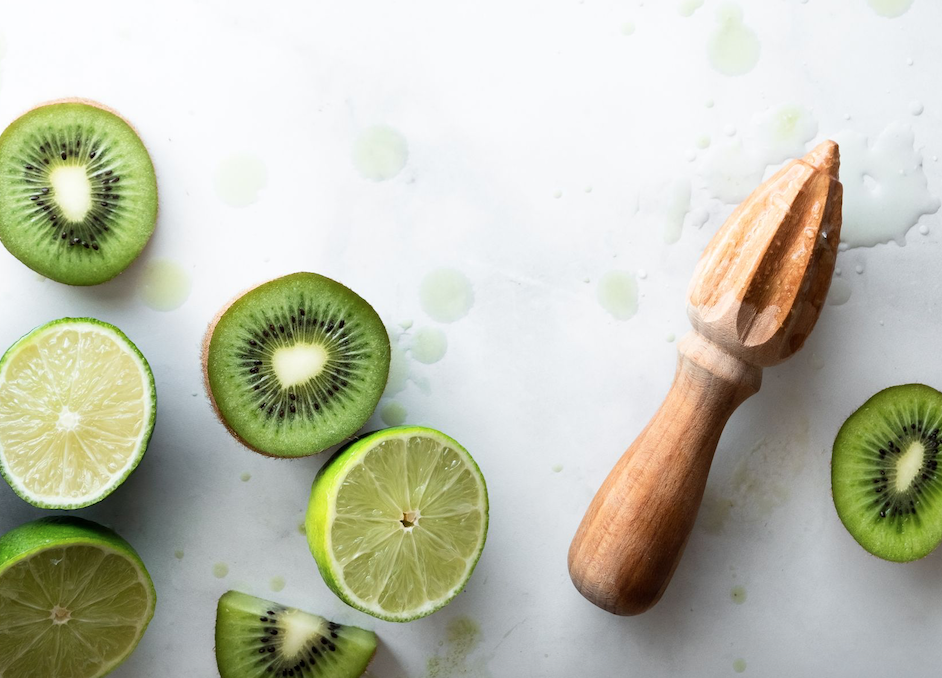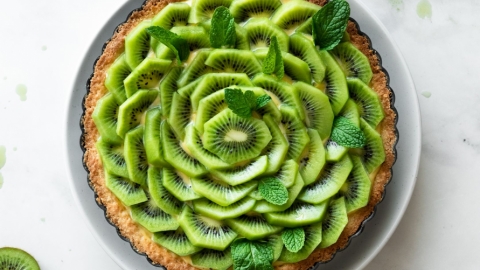Kiwifruit
My father introduced me to many fruits from around the globe. Having lived in Australia, he seemed to know a fair amount about kiwifruit and the supposed “correct” way to eat one—slice it in half, then scoop the flesh away from the skin with one satisfying turn of a teaspoon. Thereafter, kiwis became the epitome of a fun food, and I delighted in showing my friends how to eat this unusual fruit.
Kiwifruit or kiwis, as they are colloquially known, are large berries belonging to the genus Actinidia, a group of woody vine plants native to eastern Asia. Records dating back to 12th century China indicate kiwifruit or míhóutáo (macaque fruit) were harvested wild and primarily used as medicine. Kiwis were later introduced to New Zealand in 1904 and subsequently given the name “Chinese gooseberry” due to their similar taste profiles (though they are not related to gooseberry). While they gained popularity in New Zealand, it wasn’t until the 1950s that kiwi became commercially cultivated, marketed and exported to the rest of the world under the name “kiwifruit.”
Kiwi vines grow prolifically in warmer regions of the world; however, certain species are surprisingly tolerant of the Pacific Northwest. British Columbia is the only province in Canada that supports commercial production with over 450,000 kg, or 6.5 million, kiwis produced annually. In particular, hardy kiwi (Actinidia arguta) grows curiously well on South Vancouver Island. And Kiwi Cove Lodge, with over 130 active vines on their Ladysmith property, proves this plant can be more than just a novelty for the adventurous gardener.
Today, there are approximately 40 kiwi varieties available worldwide, with the vast majority imported from New Zealand and China. Hayward (Actinidia deliciosa), with its fuzzy skin and bright green flesh, is the most commonly imported variety available year-round in North America. In addition to hardy kiwi, B.C. also produces Saanichton, a large, sweet variety which can be selectively sourced from October onwards. Other varieties, such as golden kiwifruit (Actinidia chinensis) and cocktail kiwi (kiwi berry), can be sourced from time to time.
 While it is minimally wasteful to eat a kiwi the correct way (according to my father), the skin is actually edible and doesn’t need to be removed. There are purists who would argue that biting into a kiwi with its skin intact is the only way to truly appreciate this fruit. Nevertheless, kiwi is most commonly consumed raw without its skin and is used in both sweet and savoury recipes—juice blends, jams, salsas, chutney, sorbets and baked goods either directly in the mix or as a principal garnish. They also make an excellent meat tenderizer due to the presence of actinidin, a natural enzyme specific to kiwis. Kiwifruit is also a nutritional powerhouse boasting more vitamin C than oranges and more potassium than bananas. They are also rich in carotenoid antioxidants such as lutein and zeaxanthin.
While it is minimally wasteful to eat a kiwi the correct way (according to my father), the skin is actually edible and doesn’t need to be removed. There are purists who would argue that biting into a kiwi with its skin intact is the only way to truly appreciate this fruit. Nevertheless, kiwi is most commonly consumed raw without its skin and is used in both sweet and savoury recipes—juice blends, jams, salsas, chutney, sorbets and baked goods either directly in the mix or as a principal garnish. They also make an excellent meat tenderizer due to the presence of actinidin, a natural enzyme specific to kiwis. Kiwifruit is also a nutritional powerhouse boasting more vitamin C than oranges and more potassium than bananas. They are also rich in carotenoid antioxidants such as lutein and zeaxanthin.
Though it may not be common in baked goods, you’re likely acquainted with fresh kiwi layered atop Pavlova, flan or tarts—any of those applications being classic. Try your hand at this Kiwifruit & Lime Tart, where thick lime curd provides a pleasantly sour and smooth contrast to sweet, texture-filled kiwis, which can be arranged in a myriad of delightful patterns. This kiwi lime tart is light, refreshing and bursting with colour and visual intrigue—an exemplary way to showcase this extraordinary local fruit.
|
Vancouver Island and B.C. kiwi resources Whether you’re ready to shop for some fresh Island kiwi or would like to know more about growing this delicious fruit on the West Coast, these B.C. kiwi farms can point you in the right direction. Kiwi Cove Lodge, Ladysmith Peninsula Kiwi, Saanich Peninsula Petcov Kiwi Production, Abbotsford |






